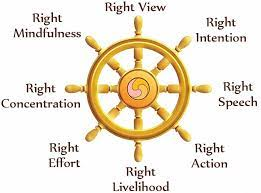 =
= 
The path factor of right livelihood has always seemed somewhat superfluous to me, since whatever work or livelihood one performs is already included in the factor of right action. Is there a reason, perhaps, that there are specifically eight factors?
I think so. I think the eightfold path has eight factors because it is a reference to ancient ideas about Ayurvedic medicine. Wikipedia says: “The earliest classical Sanskrit works on Ayurveda describe medical science as being divided into eight components (Skt. aṅga). This characterization of the physicians’ art as the teaching found in ‘the medicine that has eight components’ (Skt. cikitsāyām aṣṭāṅgāyāṃ चिकित्सायामष्टाङ्गायाम्) is first found in the Sanskrit epic, the Mahābhārata.”
These eight components of Ayurveda are in fact mentioned right at the start of Chapter 1 of the Sushruta Samhita, the oldest Ayurvedic text. I consider it extremely likely this idea of an eightfold treatment was known to the Buddha.
The similarity is clear:
- cikitsāyām aṣṭāṅgāyāṃ = eightfold treatment
- āryāṣṭāṅgamārga = noble eightfold path
The Pāli word for cikitsāyam (‘treatment’) is tikicchā. Now consider AN10.108, Tikicchaka Sutta. It mentions the three “humors” of air, bile, and pleghm that are a major aspect of Ayurvedic medicine, so there clearly is an Ayurvedic influence in this text. The Buddha tells the audience that purgatives of this kind of treatments sometimes work, but sometimes fail. But one “noble purgative” always works:
“And what is the noble purgative that works without fail? For one of right view, wrong view is purged. And the many bad, unskillful qualities produced by wrong view are purged. And because of right view, many skillful qualities are fully developed. For one of right thought, wrong thought is purged. … For one of right speech, wrong speech is purged. … For one of right action, wrong action is purged. … For one of right livelihood, wrong livelihood is purged. … For one of right effort, wrong effort is purged. For one of right mindfulness, wrong mindfulness is purged. … For one of right immersion, wrong immersion is purged. … For one of right knowledge, wrong knowledge is purged. … For one of right freedom, wrong freedom is purged.
This is the tenfold “path”, not the eightfold path. But the actual practicable factors of these ten are just the first eight. The latter two are the outcome of the path; or, in the analogy, the state of health.
Analogies to medicine are made in many other places in the Pāli canon. The Buddha is called a doctor, suffering a disease, nibbāna health, and craving a poison.
The Vimuttimagga and Visuddhimagga also quite famously compare the four noble truths to a structure found in medicine: the disease, pathogen, health and cure. This is not reflected by any Pāli sutta, but an Āgama sutra contains these ideas, though ordered somewhat differently. See Ānalayo - “Right View and the Scheme of the Four Truths in Early Buddhism − The Saṃyukta-āgama Parallel to the Sammādiṭṭhi-sutta and the Simile of the Four Skills of a Physician.”
In this scheme the treatment is the eightfold path, just like I’m suggesting. But I think the idea can be expanded further: the eightfold path has eight parts because it is analogous to the eightfold treatment of Ayurveda. I think it is possible that the Buddha did this on purpose.
It could also explain why right livelihood is included, which does seem to not be much different from right action.
We may also consider that, while nowadays Ayurveda by most of us may be seen as “alternative medicine”, in the Buddha’s days it would probably have been the main medicine. For its time it was also extremely advanced and developed, it seems, and probably well respected. In light of this, the Buddha suggesting that he was a real doctor, that he had a real medicine, I find quite inspiring.
